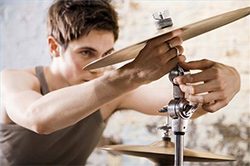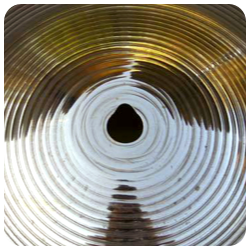Why Are My Cymbals Spinning?

Question: "My cymbal is spinning when I play it. Because of this, it is always the same area of the cymbal that is facing me. Is this normal?"
Answer: Yes! This is completely normal.
The reason why a cymbal spins is that the weight distribution of a cymbal - regardless of the model - rarely is 100% even. Even if this unevenness in weight distribution is rather small, the cymbal will naturally spin because almost all drummers mount their cymbals in a slanting position. With the help of gravity, this angle causes the heaviest part of the cymbal to face the floor. Gravity is doing its job.
Beware of Keyholes In Your Cymbal

Now that your cymbal ends up hanging in the same position time and again all by itself, it is even more important that you protect it from forming a so-called "keyhole" whenever you use it.
A keyhole is the phenomenon emerging when a cymbal's otherwise round hole is getting worn out resulting in the hole getting still more shaped as a keyhole. This typically happens over a long time with abration and it will cause the cymbal's warranty to no longer apply (a keyhole indicates to the seller that the cymbal has not been taken care of properly).
Therefore, it is important to make sure that the protecting plastic or rubber parts of the cymbal bracket are undamaged. If these are damaged, it will cause metal-on-metal contact and this damages the cymbal.
In order to prevent keyholes and to take good care of your cymbal, you can use a variety of products developed with this excact problem in mind. The Grombal Cymbal Protector and No Nuts Cymbal Sleeves are such products. No Nuts quite simply replaces the top parts consisting of felt, metal plates, and rubber with a semi-soft plastic solution. This is rather clever, as the product on the one hand eliminates the risk of causing the aforementioned keyholes, while on the other hand, it prevents losing the plates and screws that would be placed at the top of a traditional cymbal stand.
